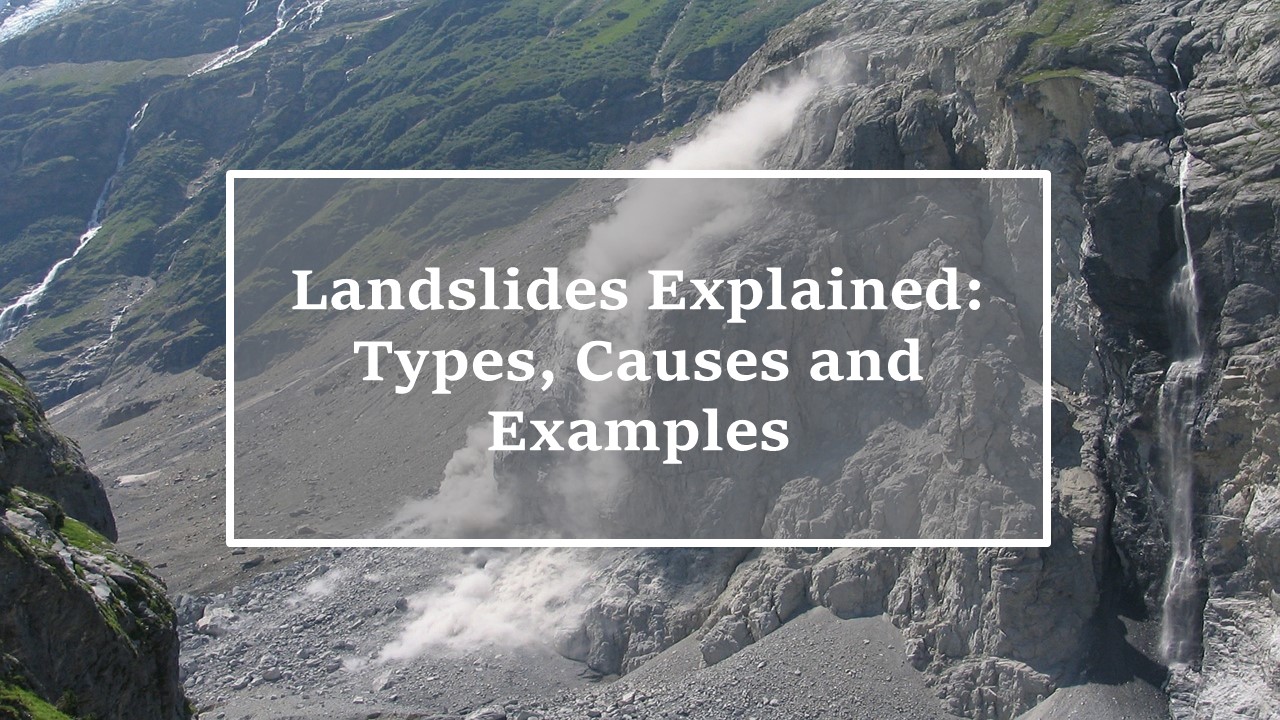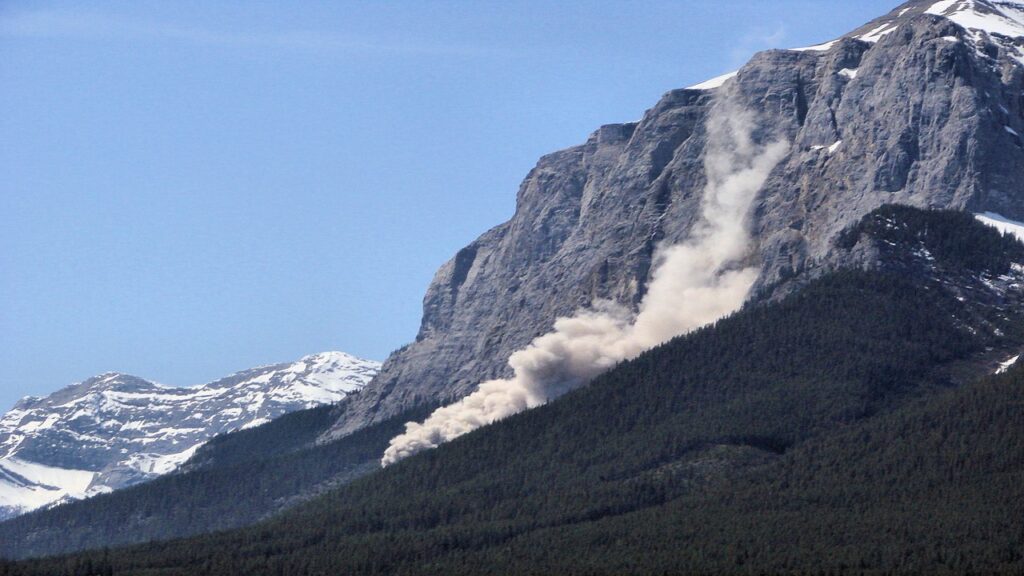Landslides Explained: Types, Causes and Examples
Posted on July 22, 2020 by Yonature

Landslides are events that occur almost everywhere slopes exist. In ancient Alps’ myths, landslides were regarded as punishment to the greedy. When people became too self-centred, the spirits of the mountains buried them alive. Today, landslide phenomena are studied in many countries as they occur widely around the globe. From mountain areas to marine units, landslides can be quite devastating disasters. It is estimated that between 1998-2017, landslides affected some 4.8 million people. What’s more, with climate change, this will only get worse.
What is a landslide?
In general, a landslide is scientifically defined as ‘the movement of a mass of rock, debris or earth down a slope’. Thus, a landslide does not necessarily mean a ‘slide of the land’. And as a general rule, downward movement is due to gravity.
As it is, the earliest record on landslides dates back to the giant 1512 slide near the Brenno River in Swiss Alps. Subsequently, Heim’s book about the Elm landslide in Swiss Alps in 1881 laid the foundation for landslide study. To date, the worst landslide recorded is the 1920 Haiyuan Flows that took place in Ningxia, China. It killed more than 100,000 people and buried the entire Sujiahe village.
Causes of landslides
Landslides occur when there is more material on the slope than it can sustain. As a result, it topples. These forces, together with slope morphology and type of slope material define the type of landslide that occurs.
Factors that increase material load on the slope
There are several natural and man-made factors that increase the load of materials on slopes. They include:
- An increase of load such as rainfall, snow, vegetation,
- An increase in lateral pressure resulting from water, roots and swelling of clay,
- Removal of underlying support including erosion of soil, previous slides, quarries and roads cuts,
- Temporary stresses like earthquakes, explosions, vibrations in vulnerable areas, and
- Geological movements related to regional tilting.

Photo from U.S. Geological Survey on Flickr
Factors that cause slopes to weaken
Likewise, when slope materials lose their strength and become too weak to sustain more load, landslides occur. Both natural and man-made factors initiate them like:
- A decrease in material strength due to natural processes like weathering,
- Processes that affect the consistency of materials such as water removal or pumping,
- Changes in internal forces like pore water pressure, and
- Changes in slope structure.
Additional causes of landslides
In addition to the above-mentioned causes, additional factors also cause landslides. For instance, as the population increases, more people settle in risk-prone regions like mountain slopes. At the same time, they cut down forests for development. With these additional stresses, landslides are more apt to happen. In rural Asia as an example, upland roads built inattentively in conjunction with agricultural activities frequently cause landslides. Now with climate change, melting ice and an increase in rainfall patterns, landslide incidence is set to increase.
How to detect landslides
Landslides can cause a lot of damage to human-built infrastructure and lives. Thus a landslide hazard assessment is used to monitor landslide events. It produces a landslide hazard map for planners to identify dangerous zones. In this way, development can be prohibited in vulnerable sites. Also, various technological tools like GIS, LiDAR and drones are useful during the assessment process to make results more accurate.
Classification of landslides
Geologists and engineers oftentimes use different definitions of landslides. This is because of the complex nature of many disciplines related to studying this event. In addition to this, varying classifications exist to denote the specific mechanics, properties and characteristics behind slope failure. Slope failure is the sudden collapse of a slope due to various influences (rain, earthquakes etc).
Broadly speaking, landslides are classified based on the type of movement and type of material. So, the type of movement refers to the way in which materials are displaced. They can be in the following form: fall, topple, slide, spread or flow. Type of material relates to the displaced material which is either rock or soil. Here, fine particles are also called earth and coarser ones called debris.
Types of landslides
1. Curved slides (Rotational slides)
A curved or rotational slide is a mass movement that occurs along a distinctive curved slip surface. This causes the original surface to be less steep. Sometimes, materials can turn around as they fall and crash, or even tilt back towards the slope. Rotational slides usually occur where the materials are homogenous and can be extremely slow. They take place when the ground is laden with water like during heavy rainfall, snowmelt and flooding.
2. Translational landslides (planar landslides)
Planar slides refer to mass movement that occurs horizontally along a flat surface. It is just like chocolate layers slipping over each other. Translational slides are one of the most common types of landslides occurring in diverse environments. They can be moderate to quite rapid and is usually associated with a rise in groundwater. This can be in the form of intense rainfall, snowmelt, flood, irrigation, pipe leakage and undercutting.
3. Topples
A topple is the forward rotation and movement of landmass out of a slope. It usually occurs around an axis near or at the base of a rock block. For instance, when waves erode the base of a cliff, eventually the upper rock mass spins forward and falls. Topples often occur along river courses and on columnar-jotted volcanic terrain. They can be very slow to quite rapid. Basically, topples occur due to water accumulation within the landmass. Other factors include undercutting, weathering, excavation, stream erosion and vibration.
4. Spreads
A spread is the lateral movement of earth materials down a gentle slope or even rather flat ground. It has a fluid-like movement and is known to occur globally where there is a lot of water. Sometimes, spreads can also cause the land to sink in (subsidence) like during earthquakes. These slides normally occur when there is too much water in the ground or because of vibrations. Usually, spreads may start out slow but can gradually become rapid.
5. Rockfalls
Rockfalls are the sudden descent of rocks or earth as they detach from slopes and cliffs. During the process, materials can bounce off angles thus breaking on impact. Or, they may also roll on steep slopes until the land flattens. Rockfalls occur worldwide especially in coastal areas and along rocky banks of rivers. Generally, movement can be rapid depending on slope steepness. Rockfalls occur due to weathering, excavation, road building, earthquakes, explosions and maintenance works.
6. Flows
In general, flow refers to the rapid, downward movement of materials due to gravity. Flows can be divided into debris flow and dry flows. A debris flow consists of coarse loose particles that slide down a slope. Dry flows or sand flows occur in detached sand. Flows can be thin and watery or thick and packed with sediment. They usually take place due to intense surface water flow.
7. Lahars
A lahar is an Indonesian term for volcanic mudflow. It is a type of debris flow that occurs along volcanic slopes. Lahar is a mix of rocky debris, volcanic materials and water. The flow can be very rapid and can spread over large expanses of land. The main reason behind a lahar is water which can come from crater lakes or condensation of volcanic steam. But most commonly, lahars occur due to snow and ice melt near a volcano.
8. Debris avalanches
Debris avalanches occur when there is a fracture on a steep slope or volcano. If water and ice are present, they accelerate the descent of materials. In this way, debris avalanches can turn into lahars or debris flows. Debris avalanches can be very rapid and can transport heavy materials far away from their point of origin. There are principally two types of debris avalanches: cold and hot. Cold debris avalanches occur when the slope becomes unstable because of erosion or other landslides. A hot debris avalanche results from volcanic activity.
9. Earthflows
An earthflow is the descent of thick fine-grained materials filled with water. Earthflows occur globally; coastal Alaska and Scandinavian countries are quite susceptible to them. They can be very slow to quite rapid and can spread over large areas. They result from intense rainfall, snowmelt, stream erosion, earthquakes, vibrations and construction.
10. Creeps (slow earthflow)
Also called slow earthflow, creep is the most common type of landslides. Creep is the gradual and slow movement of soil or rock down a slope. It can take place at specific regional places to small localized places. It happens mostly due to weathering but can also include factors like poor drainage, construction, rainfall and snowmelt.
11. Permafrost flows
Permafrost flows refer to the slump of fine-grained previously ice-rich soil on gentle slopes. They occur when surface ice melts overloading the ground with water. Shear strength is thus lost initiating the landslide. Permafrost flows are slow in nature and common in northern latitudes where the ground is mostly frozen. When the climate warms up, the flows take place. Additionally, they can happen due to wildfires, frost wedges and human activities on peat layers.
Where do landslides occur?
Landslides occur everywhere around the globe as they are initiated by various mechanisms. They occur on land and underwater; on slopes and bedrocks; on cultivated land and barren slopes. Additionally, landslides take place in dry and humid regions alike. As a matter of fact, landslides do not occur only where the slope is very steep. Shallow, gentle slopes of 1-2 degrees also fail. Nevertheless, landslides more frequently occur in fairly young tectonic mountains like the Rocky and Andes mountain chains in America. They are also common in the mountains in Japan, Taiwan and the Himalayas of South Asia.

Photo from Sheri Terris on Flickr
References
- Sassa, K., Fukuoka, H., Wang, F. and Wang, G. eds., 2007. Progress in landslide science. Springer Science & Business Media.
- Forbes, K. and Broadhead, J., 2013. Forests and landslides: The role of trees and forests in the prevention of landslides and rehabilitation of landslide-affected areas in Asia. Rap Publication, (2013/02).
- Highland, L. and Bobrowsky, P.T., 2008. The landslide handbook: a guide to understanding landslides (p. 129). Reston: US Geological Survey.
- Huang, R. and Li, W., 2011. Formation, distribution and risk control of landslides in China. Journal of Rock Mechanics and Geotechnical Engineering, 3(2), pp.97-116.
Category: Environment Tags: causes of landslides, classification of landslides, common types of landslides, countries where landslides common, countries where landslides occur, debris avalanches meaning, definition of landslide, factors that cause landslides, geography landslide, How landslides occur, landslide simple, scientific definition of landslide, types of landslides, what is a landslide, where do landslides occur, worst landslide recorded
3 Comments on “Landslides Explained: Types, Causes and Examples”
Leave a Reply Cancel reply
Get News by Email!
Categories
Search
Find Us
contact[at]yonature[dot]com
Site Links
Secure Site
Get News by Email!
Copyright © 2024 · All Rights Reserved · Yo Nature
Theme: Natural Lite by Organic Themes · RSS Feed

Pingback: Snow Avalanches Explained: Types, Causes and Examples - Yo Nature
Pingback: Wildfires Explained: Types, Causes and Examples - Yo Nature
It was interesting to learn that rocks that detach from slopes or cliffs can cause rockfalls. I’m glad you reminded me that rockfalls can happen worldwide. It’s good that there are companies that specialize in mitigating the rockfalls so it will cause less destruction.